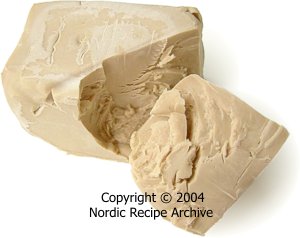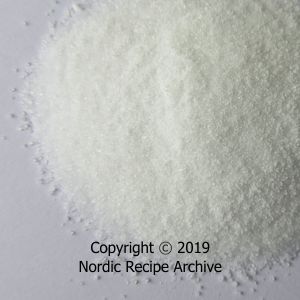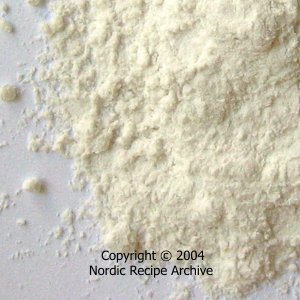|
|
|
YEAST AND OTHER LEAVENERS
Listed below are some basic leavening agents, most of which are used in Finnish cooking and in the recipes of this site.
See also:
|
|
YEAST
|
Yeast is a living, microscopic, single-cell organism (Saccharomyces cerevisiae). Fresh yeast is produced biologically by feeding yeast cells with sugar, water and oxygen so that they will start growing and dividing.
When added to various doughs, the yeast starts a fermentation process by metabolizing sugar to produce ethyl alcohol and carbon dioxide gas, which leaven the dough. The gas bubbles are trapped in a porous, elastic web produced by the flour's protein (gluten) combined with liquid, giving the dough volume.
In domestic use in Finland, mostly compressed fresh yeast and dry yeast are used in cooking. Both yeasts are used in baking but fresh yeast can also be used in making homemade beverages, like beer or Finnish mead.
The amount of yeast used varies according to the recipe, but the standard advice is
to use 25 to 50 grams of fresh yeast or about 12 grams (1 envelope) of dry yeast to every half litre of liquid (eg various bread doughs).
If the dough is rich in sugar or/and fat, always use 50 grams of fresh yeast or about 24 grams (2 envelopes) of dry yeast to every half litre of liquid (eg sweet yeast doughs).
Fresh yeast is stored loosely wrapped in refrigerator. It also keeps well frozen, for at least one year.
|

Fresh yeast

Compressed, fresh yeast is crumbled and dissolved in warm or cold liquid, according to the instructions in the recipe.
To activate the yeast, the temperature of the liquid used should be about 37 °C. In warmer temperature (40 °C+) the yeast cells will die
so the yeast will not function. Cold liquid may be used, only then leavening of the dough takes a longer time.
In baking recipes fresh yeast can be replaced with dry yeast (see right). In that case, follow the
instructions on the dry yeast package.
Finnish fresh yeast is sold in packages containing 50 grams of yeast.
|

|

Dry yeast

Dry yeast may be used instead of fresh yeast in all baking. Finnish dry yeast is never proofed, but mixed directly into dry ingredients before adding the warm liquid. To activate the yeast, the temperature of the liquid should be considerably warmer than when using fresh yeast, about 42 to 43 °C.
You can replace Finnish dry yeast by using quick-rising active dry yeast. Finnish dry yeast is sold in packages containing 2 to 4 envelopes of yeast. Each envelope contains 11 to 12 grams of dry yeast.
|
OTHER LEAVENING AGENTS AND BAKING AIDS
Leaveners other than yeast (see above) mostly produce the carbon dioxide gas needed to leaven the dough by chemical reaction rather than fermentation.
The following ingredients are suitable to be used to leaven small-sized baked goods, like cakes, quick breads, cookies, scones, muffins, pancakes and waffles.

Baking powder

Baking powder consists of baking soda [E500(ii), sodium bicarbonate, see right], some type of acidic ingredient and starch, which acts as a moisture-absorber.
Used to leaven cakes, scones, cookies and other small pastry items, baking powder is activated by the presence of moisture (the liquid in the batter) and heat (hot oven), releasing carbon dioxide leavening the batter.
Baking powder is always mixed with flour before it is added to doughs and batters. All the ingredients used together with baking powder should be chilled (liquids, melted butter etc), and the dough should be baked immediately.
However, when using slow-acting baking powder, the dough may be stored chilled for some time before baking.
Baking powder does not impart any aftertaste when used in correct amount, measured in proportion to flour. A suitable amount is to use 1 teaspoon of baking powder for every 200 millilitres of flour.
In recipes using baking soda (see right), it can be replaced with twice the amount of baking powder.
|

|

Baking soda
Sodium hydrogen carbonate, E500(ii)

Baking soda, or bicarbonate of soda, consists of sodium bicarbonate — E500(ii). It is twice as effective leavener as baking powder (see left).
Baking soda may only be used in batters and doughs that contain an acidic ingredient, like sour cream, sour milk, buttermilk, yogurt, curd cream, vinegar, lemon juice, molasses, honey, soft brown sugar, dark chocolate, non-alkalised cocoa, etc.
The acidic substance is needed to transform all the bicarbonate of soda into water or carbon dioxide, neutralizing any bitter or soapy aftertaste in the finished baked good.
Baking soda is usually mixed with cold liquid before it is added to doughs and batters. A suitable amount is to use ½ teaspoon of baking soda for every 200 millilitres of flour.
Using too much baking soda gives the baked goods an unpleasant taste of lye and a greenish tint, especially in batters and doughs that are rich in eggs.
It may also turn ingredients like sunflower seeds green, but this reaction is harmless.
Since baking soda is not activated until mixed with liquid and exposed to heat, the doughs and batters containing it may be stored chilled for some time before baking.
|
|
Hartshorn
Ammonium carbonate, E503(i) or Ammonium hydrogen carbonate, E503(ii)

Hartshorn was formerly used to leaven small and flat baked items, like cookies, and it is often mentioned in old Scandinavian and German baking recipes.
Also used for medicinal purposes, hartshorn was made from oil of hartshorn, obtained from deer antlers by dry distillation.
Nowadays hartshorn is produced commercially, consisting mainly of ammonium carbonates (E503).
Hartshorn is also known as hartshorn salt, ammonium bicarbonate and baker's ammonia.
In Finland, hartshorn is sold in pharmacies or well-equipped grocery stores/supermarkets, although it is hardly ever used in contemporary home baking or cooking. It is usually dissolved in a small amount of water before mixing into doughs. It should be noted, that hartshorn may turn ingredients like sunflower seeds green, but the reaction is not harmful.
In modern home baking, hartshorn is mostly replaced with baking powder — ½ teaspoon of hartshorn equals to 1 teaspoon of baking powder.
|
Cream of tartar
Monopotassium tartrate, E336(i)

Cream of tartar — monopotassium tartrate, E336(i) — is produced by refining the crystalline tartaric acid found deposited inside wine barrels. Tartaric acid is produced when grapes ferment.
Combined with baking soda, cream of tartar has been used as the acid ingredient in baking powders (see above).
It is also used to stabilize beaten egg whites and added to candy mixtures and frostings to give them a creamier consistency and to prevent the sugar from crystallizing.
In Finland, cream of tartar is sold in pharmacies, as it was used as a laxative in the old days. It is almost never used in Finnish home baking or cooking.
|
|
|

